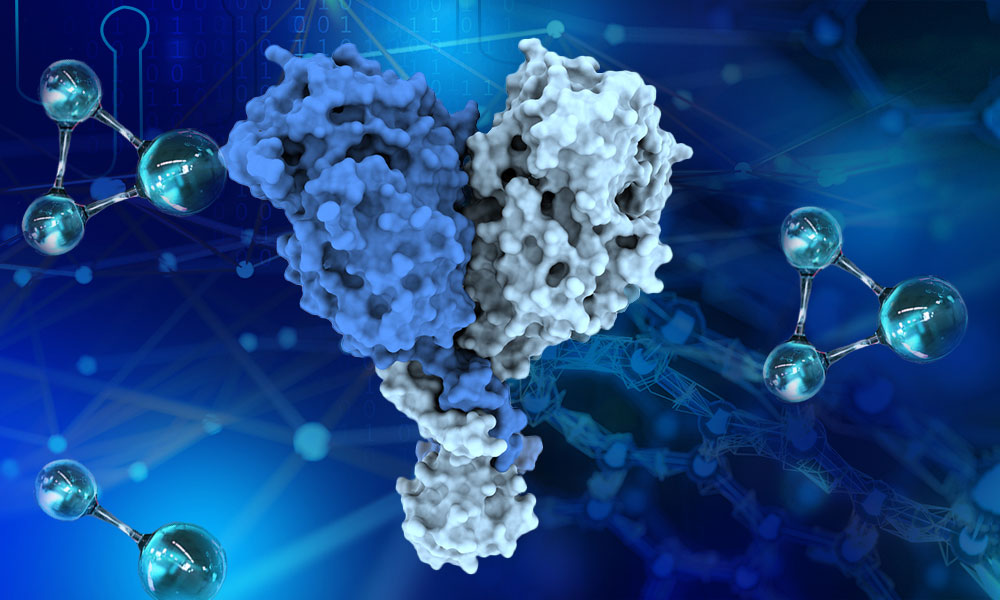
Read the latest Issue
A new paper from the Galej group at EMBL Grenoble describes the structure of key parts of the Integrator complex.

The Integrator complex, which is composed of multiple protein subunits, is involved in global regulation of the process of transcription, during which the cell’s DNA is used as a template to make instructions in the form of RNA. Knowing the structure of the Integrator complex will help scientists to better understand the interactions between its subunits and how it is involved in gene expression.
Gene expression is a highly regulated process, which involves several steps. These include transcription of DNA instructions into RNA, removal of non-coding segments from the RNA message, and its subsequent translation into proteins. All these steps involve specific molecular machineries responsible for conducting each process with high accuracy. The Galej group, based at EMBL Grenoble, studies the structure and function of the RNA–protein complexes that are involved in the regulation of gene expression.
During transcription, genetic information contained in the DNA is used to create a precursor messenger RNA (pre-mRNA) thanks to the action of an enzyme, RNA Polymerase II. To maintain only the necessary coding segments required to produce a protein, short fragments of the pre-mRNA are kept and others are removed. This process is known as pre-mRNA splicing and is catalysed by a large and dynamic RNA–protein complex, the spliceosome. This is a key focus of study for the Galej group, for which they have recently received an ERC grant.
More than 100 proteins and five small nuclear RNAs (snRNAs) are involved in building the spliceosome complex and orchestrating pre-mRNA splicing. Before the snRNAs can be incorporated into the spliceosome, they need to undergo an endonucleolytic processing step (in other words, a process where an enzyme has to cut the RNA, also called 3’-end processing), which is catalysed by the Integrator complex. Discovered fifteen years ago, Integrator remained largely uncharacterised structurally, which triggered the Galej group’s interest.
Until recently, the Integrator complex was thought to be involved mainly in the 3’-end processing of snRNAs, but studies in the past four years have begun to suggest that this might not be its major function. “We – and the scientific community – originally thought that the Integrator complex was specialised in cutting only one specific type of RNA, snRNA, but recently researchers started to realise that it is actually doing a lot more and influences thousands of RNAs from different classes. More and more evidence suggests that Integrator is one of the key players in global transcription regulation in higher eukaryotes,” explains group leader Wojciech Galej.
Recent investigation has revealed that the Integrator complex is broadly involved in the transcription attenuation process, meaning that it can make sure some genes are not expressed. Playing such an essential role in the regulation of gene expression gives even more reason to have a closer look at its molecular structure.
To study the large and dynamic 14-subunit Integrator complex, the Galej group had to combine biochemistry, cell biology, and cryo-electron microscopy (cryo-EM) imaging to determine its architecture. “A very talented PhD student in the group, Moritz Pfleiderer, used cell biology and mass spectrometry methods to first dissect this big complex into smaller modules, which are easier to handle. It was a classic divide and conquer approach,” says Galej. “Then Moritz obtained the structure of Integrator’s catalytic core using single-particle cryo-EM.” For data collection and structure determination of these subcomplexes, the group had access to cryo-EM platforms at EMBL Heidelberg and the local CM01 beamline at the ESRF, which is run with the involvement of EMBL scientists.
Cryo-EM data allowed the scientists to establish the structure and the specific arrangement of the proteins comprising Integrator’s catalytic core – the part of the complex responsible for cutting the RNA during the primary transcription process. This discovery provides insights into the interfaces between these proteins, the mechanisms involved, and how they come together inside the cell.
The results, recently published in Molecular Cell alongside the structural analysis, highlight that this complex is composed of a network of multiple subunits interacting with one another. However, several subunits have been identified as stable modules, most tightly associated with each other. “If you try to break down this complex, it will be divided into three or four different pieces, which quite likely constitute its building blocks inside the cell,” says Galej.
With this new structure, the Galej group has come up with some new ideas about how RNA could be recognised by the Integrator complex. These are important insights, as they suggest how the substrate might be delivered to the enzyme’s active site, where the reaction happens. Interestingly, Integrator has some similarities with other cellular machineries involved in the 3’-end processing of the messenger RNAs that encode proteins. However, the inner arrangement of the Integrator proteins is quite unique compared with the other 3’-end processing complexes, and some proteins are twisted in their positions. This peculiar architecture could have played an important role in the specialisation of this complex, which evolved to fulfil different functions.
Although the study provides the first insights into the architecture of Integrator’s catalytic core, more investigations are needed to characterise additional parts of the complex and their involvement in gene expression. Ongoing studies in the Galej group should provide such insights, as well as unravelling the molecular basis of some of the genetic disorders associated with mutations in the components of the Integrator complex, which can result in neurodevelopmental disorders. These studies could facilitate drug design to target these mutations in the future.
Looking for past print editions of EMBLetc.? Browse our archive, going back 20 years.
EMBLetc. archive